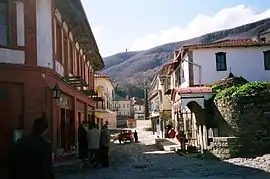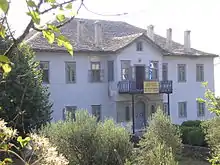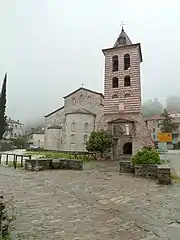Karyes, Mount Athos
Karyes (Greek: Καρυές) is a settlement in Mount Athos. It is the seat of the clerical and secular administration of the Athonite monastic state. The 2011 Greek census reported a population of 163 inhabitants. It is the largest settlement in Mount Athos.
Karyes
Καρυές | |
|---|---|
 Street in Karyes | |
 Karyes | |
| Coordinates: 40°15.429′N 24°14.698833′E | |
| Country | Greece |
| Administrative region | Mount Athos |
| Population (2011)[1] | |
| • Rural | 163 |
| Time zone | UTC+2 (EET) |
| • Summer (DST) | UTC+3 (EEST) |


The major church at Karyes is the Protaton, which is the church of the Protos, or president of the monastic community.
Geography
Climate
| Climate data for Karyes, Greece | |||||||||||||
|---|---|---|---|---|---|---|---|---|---|---|---|---|---|
| Month | Jan | Feb | Mar | Apr | May | Jun | Jul | Aug | Sep | Oct | Nov | Dec | Year |
| Average high °F (°C) | 49 (9) |
52 (11) |
59 (15) |
66 (19) |
76 (24) |
86 (30) |
90 (32) |
90 (32) |
80 (27) |
71 (22) |
59 (15) |
51 (11) |
69.083 (20.60) |
| Average low °F (°C) | 34 (1) |
36 (2) |
41 (5) |
47 (8) |
56 (13) |
65 (18) |
69 (21) |
69 (21) |
61 (16) |
54 (12) |
45 (7) |
37 (3) |
51.166 (10.65) |
Source: <World Weather Online= >Karyes Monthly Climate Average, Greece. World Weather Online. 2016 http://us.worldweatheronline.com/karyes-weather-averages/mount-athos/gr.aspx. Retrieved 13 September 2016. Missing or empty |title= (help) | |||||||||||||

_%D0%A1%D0%B2%D0%B5%D1%82%D0%B5_%D0%B3%D0%BE%D1%80%D0%B5_%D1%83_%D0%9A%D0%B0%D1%80%D0%B5%D1%98%D0%B8_-_panoramio.jpg.webp)
History
Serbian Bishop Saint Sava built a church and cell at Karyes, where he stayed for some years, becoming a Hieromonk, then an Archimandrite in 1201. He wrote the Karyes Typicon during his stay there, and a marble inscription of his work still exists.[2] In 1219 Sava becomes the first Archbishop of Serbia.[2]
In the year 1283, Latin Crusaders during the reign of the Byzantine Emperor Michael Paleologos, attacked Mount Athos. They tortured and hanged the Protos, and sacked the Protaton, murdering many of the monks. These monks are commemorated as martyrs by the Orthodox Church on December 5 (for those churches which follow the traditional Julian Calendar, December 5 falls on December 18 of the Gregorian Calendar).
Sources
- "Απογραφή Πληθυσμού - Κατοικιών 2011. ΜΟΝΙΜΟΣ Πληθυσμός" (in Greek). Hellenic Statistical Authority.
- Đuro Šurmin, Povjest književnosti hrvatske i srpske, 1808, p. 229
External links
| Wikimedia Commons has media related to Karyes (Athos). |
- Monastic Martyrs of Karyes Orthodox synaxarion